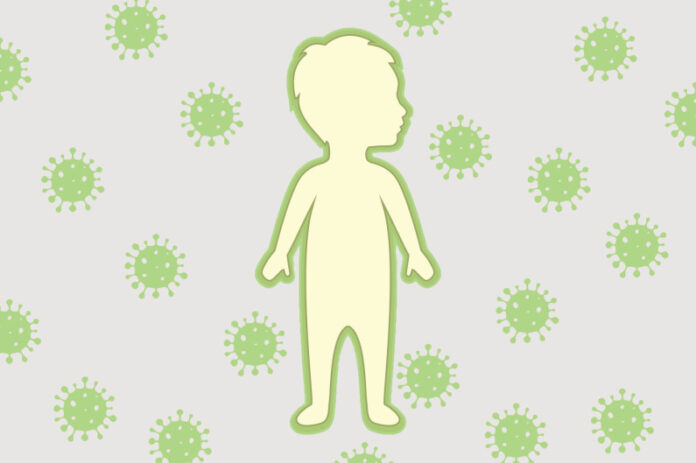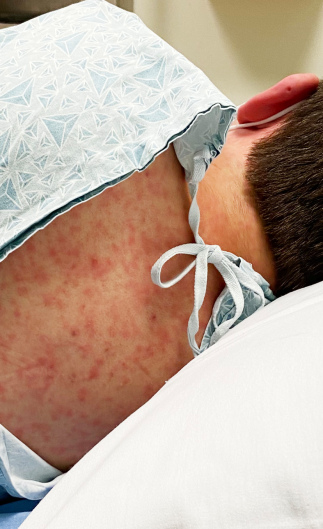
Elizabeth Aguilera | CalMatters
A rare but serious syndrome linked to coronavirus is striking California children, with cases rising across the country. The discovery comes as the state grapples with how kids can safely return to group settings.
Within hours of walking her teenage son into a Long Beach hospital for a burning fever and angry red rash that exploded across his body, Marla Maxfield watched helplessly as he was rushed into the intensive care unit.
“He was so swollen, his face looked like he had been sunburned, his hands and feet were red, his tongue was swollen and the edges were really red,” Maxfield said. “It was terrifying.”
Doctors diagnosed Maxfield’s 14-year-old son with multisystem inflammatory syndrome, a new condition in kids that has been linked to coronavirus. What began last month as a sore throat and low-grade fever—and was initially diagnosed as strep throat—had become a full-blown medical emergency requiring six days in the hospital.
Just when it seemed that kids would be OK in the pandemic, this new related illness is hospitalizing a growing number of children and young people—first in New York, and now in California and other states.
The majority of children who do get infected with coronavirus experience mild to no symptoms. Until recently, the biggest concern had been that they could be vectors, or carriers, of the virus to more vulnerable populations.
“For the most part, children were getting away relatively unscathed,” said Dr. Irving Steinberg, associate professor of clinical pharmacy and pediatrics at the USC School of Pharmacy and Keck School of Medicine of USC. “On one hand, kids seemed to be spared the worst of coronavirus infections but could be asymptomatic carriers in their mouth or their nose and risk spreading it to others. Hence grandparents separated from grandchildren.”
“HIS BODY JUST FOUGHT A WAR AND HE NEEDS TIME TO HEAL.” – Marla Maxfield, Orange county mother
But now, several hundred cases of the new inflammatory syndrome have been reported in the U.S. It is marked by inflammation throughout the body, affecting blood vessels and organs such as the heart or kidneys, and could lead to coronary aneurysm and toxic shock. Medical experts say it may be a hyperinflammatory response to having had the coronavirus infection several weeks before. Most of the children affected have tested positive for coronavirus, have coronavirus antibodies or been in close proximity to an adult with COVID-19, according to the Centers for Disease Control and Prevention.
So far, the state Department of Health has confirmed fewer than 11 cases in each of these three Southern California counties: Los Angeles, Orange and San Diego. CalMatters has identified at least six cases in Los Angeles, one in Long Beach and one in Orange County. One more case has been reported by Valley Children’s Healthcare in Madera, in the Central Valley, and is being investigated – but is apparently not reflected in the state’s statistics.
Discovery of the syndrome comes as California wrestles with how and when children can return to group settings like child care, school or camp. While inflammatory syndrome cases are still rare, some fear the number could rise as more children come in close contact again and begin getting coronavirus.
“It’s one of the many things that is going to have to be taken into account,” said Angela Rothermel, director of early childhood policy at Children Now, a public policy advocacy organization focused on kids. “How do we set up policies around early care and education to keep providers safe and keep kids safe?”
For younger children, Rothermel said, the state is expected to issue more in-depth child care guidance soon—and she expects the syndrome will be a factor. Whatever is released, she said, it will need to provide clear guidelines and resources, such as the cost of disinfection, personal protective equipment and other safety needs.
“It’s in the state’s hands to put the policy forward and equip providers so that parents can feel good and safe about sending their children back to these providers,” she said. “Many of us can’t work without child care.”
The California Department of Education is closely monitoring the emergence of the syndrome as it decides how to safely move forward with school, department spokesman Daniel Thigpen stated in an email.
He said he did not have specifics, but that school reopening guidance will be released soon.
“We are working with public health officials to ensure we are guided by the latest science as we support our schools in the weeks and months ahead,” he wrote.
In New York, where the syndrome first appeared in the U.S., 179 cases and three deaths have been reported since April. According to media accounts, cases also have appeared in more than 20 other states: New Jersey with 26, Colorado with four, Louisiana with 13—including one death—and Florida, where seven cases have been tallied.
The low number of cases poses a dilemma for both parents and policy makers, forced to make decisions about sending children back to group settings without much information about the syndrome.
“As a parent, I have to weigh everything out and not live in fear – but at the same time you are always questioning if you are making the right decision,” said Rocio de la Torre-Gonzalez, who sent her 4-year-old back to half-day preschool in mid-May. “This is uncharted territory. We’ve never been in a situation like this. It could be a matter of life and death.”
Since March, her child had been staying home on the days de la Torre-Gonzalez worked from home, and is cared for by family other days. The Whittier mom has a job at the county courthouse and has been going in every other day.
“It is concerning, except I kind of have no choice because I’m starting full throttle at work on June 22,” she said about returning to the courthouse full-time when it fully opens. “I’m taking as many precautions as I can.”
In May, the Centers for Disease Control and Prevention named the condition Multisystem Inflammatory Syndrome in Children, or MIS-C (previously known as pediatric multisystem syndrome or PIMS). The agency issued a health warning on May 14 and is requiring that all cases be reported.

Orange County mom Marla Maxfield’s 14-year-old son spent six days in the hospital battling the syndrome. A red rash is one of the telltale signs of a new inflammatory illness linked to coronavirus in kids. Photo courtesy of Marla Maxfield
On May 12, when asked at a congressional hearing about kids going back to school, Anthony Fauci, director of the National Institute of Allergy and Infectious Diseases, mentioned the syndrome and said there are still many unknowns about the virus.
“We really better be very careful, particularly when it comes to children because the more and more we learn, we’re seeing things about what this virus can do,” he testified.
The syndrome was first reported overseas, including in Italy and the United Kingdom. A new study on a small cohort of Italian children published in the journal Lancet showed that the syndrome is probably linked to coronavirus.
“I still think COVID-19 is relatively uncommon in children and I think severe disease manifestation in children is very rare. But clearly there appears to be this group of children that becomes very ill because of COVID-19 infection,” said Dr. Hayden Schwenk, clinical associate professor of pediatric infectious diseases at the Lucile Packard Children’s Hospital Stanford.
As of May 27, children under 18 made up 5.2% of all positive coronavirus cases in California, according to the Department of Public Health.
Schwenk said the syndrome isn’t contagious because it seems to occur several weeks after a child may have had the infection. But if more children contract coronavirus, these post-infection inflammatory response cases also could rise, he said.
Cases of the new syndrome began to show up in the U.S. in April. At first, doctors considered the cases to be a rare illness known as Kawasaki disease or Kawasaki-like. Kids were exhibiting similar symptoms, such as prolonged fever, rash, swollen feet and hands.
Kawasaki is a rare condition that affects little more than 5,500 kids a year in the U.S. It is considered a hyper-reaction to an infection that causes inflammation across the body, said Dr. Jackie Szmuszkovicz, pediatric cardiologist and Kawasaki disease specialist at Children’s Hospital Los Angeles. Kawasaki typically affects kids under 6 and can cause inflammation of the artery walls, which impacts the heart and other organs. Doctors don’t know what causes it.
“THERE ARE ALWAYS GOING TO BE SOME KIDS WHO REACT DIFFERENTLY TO A VIRUS OR AN INFECTION AND HAVE MORE SERIOUS OUTCOMES.” – Dr. Negar Ashouri, infectious disease physician
An unusual uptick of Kawasaki cases in April at Children’s Hospital Los Angeles tipped off doctors that something was off, said Szmuszkovicz. Physicians began reviewing the cases for indications that they were actually the new syndrome related to coronavirus and testing the children for antibodies.
Of the 21 Kawasaki cases since April 1, six of them turned out to be the inflammatory syndrome where the children tested positive for coronavirus antibodies. The affected children ranged from 6 months to 8. Five of the children showed Kawasaki-like symptoms and one was experiencing shock. All have recovered and were discharged.
Doctors will continue testing children identified as Kawasaki or syndrome patients to see if they develop antibodies over time.
“We realize that we are dealing with something new, that may have a broad system of disease,” Szmuszkovicz said. “Some children are having very severe illness, as severe as shock.”
Children’s Hospital Orange County has had one case so far of the syndrome and has sent letters to recent Kawasaki patients, explaining the syndrome and asking them to take antibody tests, said Dr. Negar Ashouri, infectious disease physician at the hospital.
The boy, a preteen, was in the intensive care unit for a month before going home in April, she said. He was tested for coronavirus and for antibodies, but both tests were negative.
But that doesn’t mean the syndrome isn’t related to COVID-19, Ashouri said, noting that testing is unreliable and there are still many unknowns.
“There are always going to be some kids who react differently to a virus or an infection and have more serious outcomes. That is something we are learning about as we see how this virus progresses,” Ashouri said.
For Marla Maxfield and her son, the ordeal is far from over.
Maxfield took her son home from the hospital on Monday and is waiting on the results of his coronavirus antibody test.
The teen still has remnants of the splotchy red rash, swollen lymph nodes and is taking aspirin daily to avoid blood clots. Echocardiograms at the hospital showed his heart was not damaged, but he has two more echo tests in coming weeks to monitor his recovery, his mom said.
“I don’t know what the residual effects will be,” said Maxfield. “His body just fought a war and he needs time to heal.”
Maxfield has since joined a social media parent group about the syndrome to share her experience with other parents. She said she did everything possible to isolate her family and still wonders how her son got sick. Now, Maxfield wants other parents to know what signs to look for in their own children, and to seek treatment as soon as possible.
“I’m just very lucky and very blessed that we got there early,” Maxfield said through tears. “It’s like having a newborn again when you have one eye open all the time to make sure they are alive. That’s how I’m going to be now, checking on him throughout the night to make sure he’s okay.”


